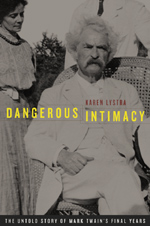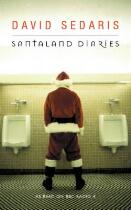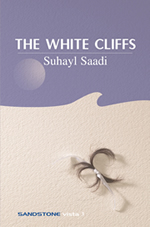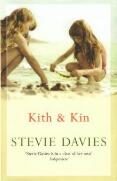Book Reviews
by anna battista
Karen Lystra , Dangerous Intimacy: The Untold Story of Mark Twain's Final Years (University of California Press)
 Sam Clemens, better known as Mark Twain, one of America's most famous writers, was surely a witty and talented man and lecturer, yet while he mastered words and writing in an impeccable way, business and financial matters constituted a problem for him. Indeed, Twain’s poor investments were the cause of his bankruptcy in the 1890s, which were also tragic years for other reasons. In 1896, his youngest child Jean had her first epileptic seizure, and his oldest daughter Suzy, his favourite, died from meningitis. A few years later, in 1904, Twain's wife, Olivia, died of heart disease. Twain was 69 when he was left with two unmarried daughters in their 20s, Jean, an epileptic, and Clara, who was determined to pursue her career as a singer. Clemens soon hired 38-year-old Isabel Lyon as his personal secretary, but little did he suspect that this would have been one of the greatest mistakes he ever did in his life.
Sam Clemens, better known as Mark Twain, one of America's most famous writers, was surely a witty and talented man and lecturer, yet while he mastered words and writing in an impeccable way, business and financial matters constituted a problem for him. Indeed, Twain’s poor investments were the cause of his bankruptcy in the 1890s, which were also tragic years for other reasons. In 1896, his youngest child Jean had her first epileptic seizure, and his oldest daughter Suzy, his favourite, died from meningitis. A few years later, in 1904, Twain's wife, Olivia, died of heart disease. Twain was 69 when he was left with two unmarried daughters in their 20s, Jean, an epileptic, and Clara, who was determined to pursue her career as a singer. Clemens soon hired 38-year-old Isabel Lyon as his personal secretary, but little did he suspect that this would have been one of the greatest mistakes he ever did in his life.
Ambitious Lyon, also known as the “Lioness” (a nickname Clara had given her while their relationship was full of love and attention), practically managed to exile Jean, confining her to sanitariums, reduced Clara’s allowance while spending Twain’s money as if it was her own and tried to seduce Twain in hopes of marrying the man she used to call “the King”, who was almost thirty years her senior. Later on, Lyon and Twain’s fraudulent business manager Ralph Ashcroft, whom she later married, literally tried to ruin Sam Clemens, but Clara exposed their plan before it was too late.
This is a well-known story in Twain’s life, but Karen Lystra, Professor of American Studies at California State University at Fullerton, adds something else to this biography of Mark Twain. It’s the figure of Jean she analyses and focuses on, throughout the pages of this volume, through her diaries which Lystra found in 1987. Towards the end of the book, Jean is finally reunited with her father and together they live some idyllic yet brief moments: indeed Jean had a seizure and drowned in her bathtub on Christmas eve 1909 (towards the end of the book, Lystra includes Twain’s the ‘Closing Words of My Autobiography’, the story of Jean’s death, in its original form), while Twain died five months later.
What comes out of this book is a very sad tale about a father who literally abandoned his daughter (Twain trusted Lyon to read him Jean’s letters from her exile, but he didn’t suspect she edited them), recounted in a very human way. Through the twenty chapters of Dangerous Intimacy, Lystra also analyses the figure of Mark Twain and the unpublished Ashcroft-Lyon manuscript, his 429-page autobiographical exposé, which Lystra re-evaluates as the manuscript in which Twain told the truth, all the truth and nothing but the truth, about the events that marked the last years of his life. Lystra is very good at presenting the prejudices that surrounded epilepsy in those times and the family drama lived by Sam Clemens, who was almost turned by his two servants into an American King Lear (Twain’s employees believed “that all in good time they would be indisputably supreme here,” he wrote in the Ashcroft-Lyon manuscript, “& I another & stripped forlorn King Lear.”).
Dangerous Intimacy is a well-researched book that will definitely continue to stir interest in the figure of Mark Twain.
David Sedaris, Santaland Diaries (Phoenix)
 It’s Christmas time, and there’s definitely need to be afraid. In any shop you’ll go to, you’ll be subjected to listen to appalling Christmas songs: apart from the Christmas classics, now you also have Band Aid’s “Do They Know It's Christmas?” and Frankie Goes To Hollywood’s “Power of Love”, revamped ‘80s hits that for most of us will feel like nightmares from the past suddenly coming to haunt the present and the future. Not to talk about cinema: this is the season when very crap films go straight to the top of the charts because people with bad tastes, not having anything to do during the holidays, decide to go to the movies. And what about demented and embarrassing Christmas parties? What about shop till you drop to find the right present for the wrong person? If you are anti-(this sort of)Christmas, then David Sedaris’ Santaland Diaries (Phoenix) is the book for you.
It’s Christmas time, and there’s definitely need to be afraid. In any shop you’ll go to, you’ll be subjected to listen to appalling Christmas songs: apart from the Christmas classics, now you also have Band Aid’s “Do They Know It's Christmas?” and Frankie Goes To Hollywood’s “Power of Love”, revamped ‘80s hits that for most of us will feel like nightmares from the past suddenly coming to haunt the present and the future. Not to talk about cinema: this is the season when very crap films go straight to the top of the charts because people with bad tastes, not having anything to do during the holidays, decide to go to the movies. And what about demented and embarrassing Christmas parties? What about shop till you drop to find the right present for the wrong person? If you are anti-(this sort of)Christmas, then David Sedaris’ Santaland Diaries (Phoenix) is the book for you.
The volume contains six tales, all about Christmas: the title story is about Sedaris working as Christmas elf at the New York-based department store Macy’s. After going through four mildly hellish training days in which, among the other things, the elves are instructed on how to greet people (“Interpreters for the deaf came and taught us to sign, ‘MERRY CHRISTMAS! I AM SANTA'S HELPER.’ They told us to speak as we sign and to use bold, clear voices and bright facial expressions. They taught us to say, ‘YOU ARE A VERY PRETTY BOY/GIRL! I LOVE YOU! DO YOU WANT A SURPRISE?’ My sister Amy lives above a deaf girl and has learned quite a bit of sign language. She taught some to me and so now I am able to say, ‘SANTA HAS A TUMOR IN HIS head THE SIZE OF AN OLIVE. MAYBE IT WILL GO AWAY TOMORROW BUT I DON'T THINK SO.’) and wear sensible pants under their costumes, Sedaris lives a few truly hellish days, working as entrance elf, magic window elf, emergency exit elf, counter elf, magic tree elf, pointer elf, santa elf, photo elf, usher elf, cash register elf and exit elf. Sedaris the elf gets bullied by aggressive and bossy parents (who instruct their kids on how to pose on Santa’s lap for the Christmas picture), by kids and by occasionally racist or psychotic families and individuals.
Some of the other tales collected here are dark, cynical or cruel: in “Dinah, the Christmas Whore” a young Sedaris is spared a boring Christmas by an unusual encounter with a prostitute in his family’s kitchen; “Christmas Means Giving” recounts the story of two rich families destroying themselves while competing to show who’s the kindest between them.
With Santaland Diaries (originally published in 1999), American satirist David Sedaris, author of the bestselling Barrel Fever (1994) and Naked (1997) and of the more recent Me Talk Pretty One Day (2000) andDress Your Family in Corduroy and Denim (2004), manages to destroy the image of a classic merry, joyful and cute Christmas in an admirable way.
“Playwright, author, radio star, and retired elf David Sedaris may be the most brilliantly witty New Yorker since Dorothy Parker,” wrote The New York Magazine a while back. It might as well be true.
Suhayl Saadi, The White Cliffs (Sandstone Press)
 If you’ve been a keen reader since you were a kid, you are the sort of person who thinks books are your life and you wouldn’t be able to live without them. Yet, there are people who get into books and writing when they are adults: little by little, they master reading, overcome any difficulty it had for them and get into books very enthusiastically. The problem is that there are not many books aimed at such emergent adult readers, at least there weren’t up to now.
If you’ve been a keen reader since you were a kid, you are the sort of person who thinks books are your life and you wouldn’t be able to live without them. Yet, there are people who get into books and writing when they are adults: little by little, they master reading, overcome any difficulty it had for them and get into books very enthusiastically. The problem is that there are not many books aimed at such emergent adult readers, at least there weren’t up to now.
Sandstone Press, a publishing house established in Highland (also publisher of the Sandstone Review a free online literary magazine), has recently started publishing short novels for emergent readers. It is a hard challenge in many ways to publish novellas, a genre loved all over the world, but often difficult to sell in the UK, for adults, written by established authors. Up to now, Sandstone Press published three novellas, Isla Dewar’s The Cherry Sundae Company, Des Dillon’s The Blue Hen and Suhayl Saadi’s The White Cliffs.
The novella by Glasgow-based writer Saadi, author of the novel Pshychoraag (Black and White Publishing, 2004) and of the anthology The Burning Mirror (Polygon 2001), is a story suspended between Italo Calvino and Jorge Luis Borges. The White Cliffs tells the story of Adam and Lily: the two meet in a seaside café in winter, Adam is a writer who hasn’t been writing much, Lily is a waitress and claims she is French, both are looking for love and soon find it. One day they hire a boat and head towards a mysterious dark shape they’ve seen emerging from the sea for a few days. They discover the mysterious place is a giant white rock that hides secrets and ghosts from a past they have forgotten a long time ago.
Saadi’s The White Cliffs is a perfect book not only for emergent readers, it’s indeed an excellent short read for everyone. It will definitely sprinkle your day with that dose of magic realism it usually lacks.
Stevie Davies, Kith and Kin (Weidenfield & Nicholson)
 Kith and Kin opens with two cousins, Mara and Aaron, quarrelling over the ashes of their beloved cousin Francesca. This first scene summarises in a way the rest of this book that explores endless quarrels and feuds among families (“the Evanses, Menelauses and Thomases were linked by intermarriage and sundered by grudges of fabulous longevity and labyrinthine complication,” author Stevie Davies writes at some point in the novel), often over family proprieties and even over the memory of Francesca (Frankie), a reckless member of the family, who committed suicide when she was in her early twenties.
Kith and Kin opens with two cousins, Mara and Aaron, quarrelling over the ashes of their beloved cousin Francesca. This first scene summarises in a way the rest of this book that explores endless quarrels and feuds among families (“the Evanses, Menelauses and Thomases were linked by intermarriage and sundered by grudges of fabulous longevity and labyrinthine complication,” author Stevie Davies writes at some point in the novel), often over family proprieties and even over the memory of Francesca (Frankie), a reckless member of the family, who committed suicide when she was in her early twenties.
After this first scene, Davies transports us to the present time: we meet a middle-aged Mara who is conducting research into the phenomenon of the phantom limb among amputees. The past comes back to haunt her when, after watching a video on TV about the Sixties that also shows Frankie singing, Mara starts re-examining those years, trying to find the truth about Frankie's early suicide and, possibly, to solve the mystery about who’s the real father of Frankie’s son Zack. While doing this, Mara gets in touch again with lost members of her family, among them also Susan, Frankie’s mum, who’s gone senile and mistakes her for Francesca; Jack, Frankie’s violent and alcoholic stepfather, and cousin Aaron, with whom both Mara and Frankie had an intense and sexual relationship.
On her way to discovering the truth about Francesca (and while Mara’s daughter, Menna, is herself trying to re-establish contact with her Uncle Aaron), Mara also remembers growing up with her cousin: we meet the two during their childhood in South Wales, when Francesca, traumatised by the death of her father and disliking Jack, tried hard to become a member of Mara’s family; we explore the lives of the two girls when they grew up and got enmeshed in the flower-power revolution at the family home, Breuddwyd, turned by Frankie into the hippy Beloved Community; we see Francesca vandalising her Republican uncle and aunt’s house during a trip to Texas with Mara.
Davies portrays Frankie as a self-destructive but charismatic child of the Sixties: she is the spiritual daughter of Janis Joplin and Bob Dylan, she is obsessed with the destructive George whom Mara the young feminist hates as she hates the limited role of women in hippy communities (Mara comments, "The men were tongues; the girls were ears. The ears cosied up to the tongues of choice and allowed themselves to receive the benefit of their windbag garrulities with every appearance of worship. It was worse than bloody chapel").
Stevie Davies' first novel since The Element of Water (The Women's Press, 2001 – longlisted for the Booker and Orange Prizes and winner of the Arts Council of Wales Award) is about destructive bonds, jealousy, resentment, growing up and the dark secrets hid by all families. It is above all about the devastating power of love, “To love,” Davies writes at a certain point of her novel, “might involve being aggrieved, vicious, raw; it might compel you to cut dead your kith and kin when you met them in the street, because love was rivalrous, was theft and cheating. Love might inhabit a zone of murderous danger and still be love.” Kith and Kin is a poetically and beautifully written dark and sad story.
Copyright (c) 2005 erasing clouds |
|